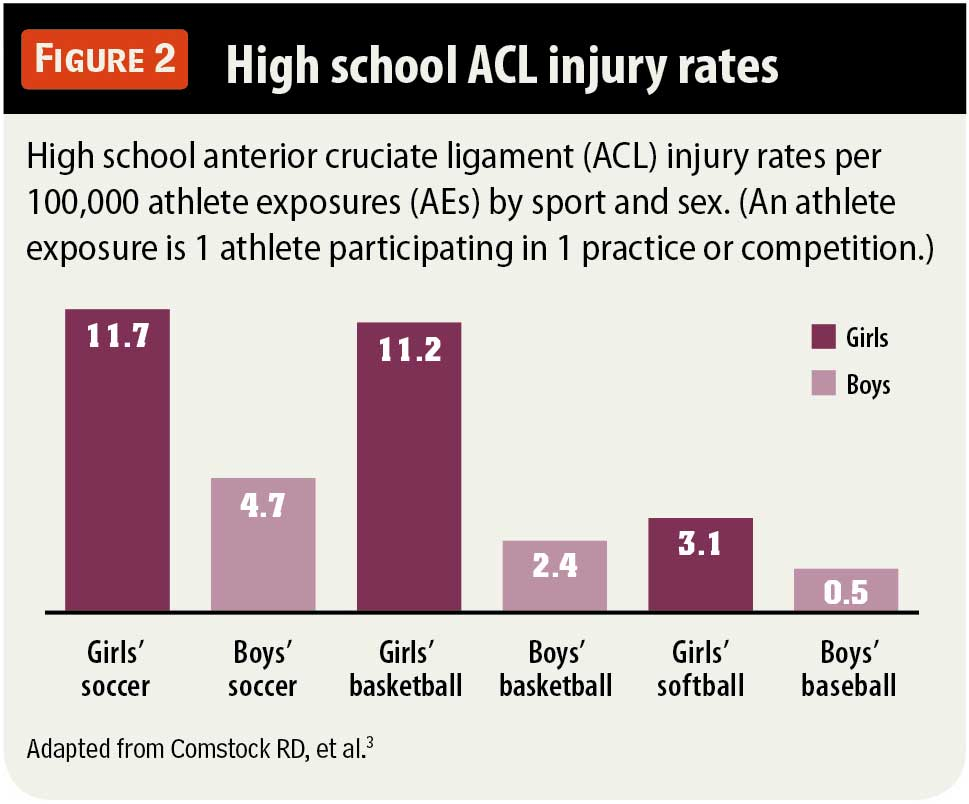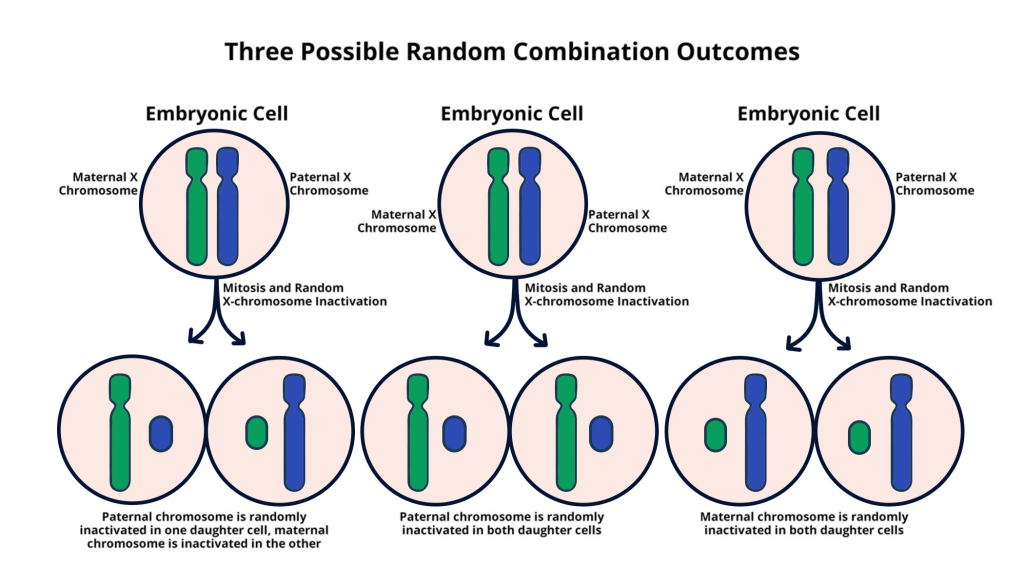
ACL injury rates among women athletes have garnered significant attention in recent years, particularly as they are reported to be 1.7 times higher than their male counterparts. This alarming trend has sparked extensive ACL injury research, delving into the reasons behind the heightened vulnerability of female athletes to ACL tears. Factors such as hormonal differences and anatomical discrepancies have often been highlighted, yet recent studies suggest that it’s not just biological sex differences at play; social contexts are equally influential. Women sports injuries, especially ACL tears, could be linked to underfunding and lower team sizes, resulting in increased competition exposure. Sports science gender differences reveal a pressing need to rethink how we evaluate and prevent these injuries in female athletes.
The elevated occurrences of anterior cruciate ligament injuries among female athletes represent a complex interplay of physiological and social dynamics. Known as ACL tears in women, these injuries are becoming a focal point in discussions about disparities in athletic health. Current analyses suggest that the structure of women’s sports, including factors like smaller team sizes and less training time, may significantly impact injury rates. This ongoing investigation into female athlete injury rates emphasizes the importance of addressing not only biological factors but also the social framework surrounding women in sports. By acknowledging these varied elements, we can better understand the significant health issues faced by women athletes in competitive environments.
Understanding ACL Injury Rates in Women Athletes
The anterior cruciate ligament (ACL) injury rate among women athletes is a topic of considerable concern in the field of sports sciences. Research indicates that female athletes are 1.7 times more likely to sustain ACL injuries compared to their male counterparts. This statistic underscores the pressing need to delve deeper into the factors that contribute to these disparities. While biological differences have traditionally been emphasized, recent studies suggest that social and structural conditions may play equally crucial roles in influencing injury rates among women in sports.
Moreover, it is essential to consider the environment in which female athletes train and compete. Female athletes often participate in smaller teams, where practice time may be significantly less than that of male teams. This lack of opportunity for effective conditioning makes them more vulnerable to injuries during high-competition scenarios. Thus, the context of ACL injury rates in women athletes is not purely biological; it is deeply intertwined with the societal and structural inequalities in sports.
The Role of Sports Science in ACL Injury Research
The field of sports science plays a pivotal role in understanding ACL injuries among women athletes. Traditional metrics, such as ‘athlete exposures,’ have been criticized for failing to consider critical variables affecting injury rates. For instance, many studies simply tally the number of players and the frequency of games, overlooking the need for a more nuanced approach that accounts for the specific training conditions of female athletes. This oversight can lead to skewed conclusions about the causes and prevention strategies for ACL injuries in women.
Recent studies from Harvard’s GenderSci Lab emphasize the importance of refining metrics used in ACL injury research. By delving into individual athlete training-to-competition ratios and accounting for team dynamics, researchers aim to better represent the true risks female athletes face. As more comprehensive data emerges, it is anticipated that injury prevention strategies will evolve, moving towards tailored approaches that specifically address the unique challenges women face in competitive sports.
Exploring Social Factors Behind Women Sports Injuries
The conversation around ACL injuries among women athletes cannot ignore the social factors at play. Evidence suggests that lower investment in women’s sports leads to inadequate training facilities and insufficient access to resources like physical therapists. These disparities contribute significantly to the higher incidence of ACL injuries among female athletes. By identifying social inequalities within sports structures, researchers can highlight the need for better funding and training opportunities for women.
Furthermore, the athlete exposure metrics that have historically dominated sports science research often fail to reflect the reality of women’s sports environments. The imbalance in how male and female athletes experience competition and training leads to biases in understanding injury risk. A more thorough examination of these social factors is essential for creating equitable sports programs that prioritize health and performance for women, ultimately mitigating the risks of sports injuries like ACL tears.
Impact of Team Size on Injury Rates in Female Athletes
The size of a sports team can greatly influence injury rates, particularly in women’s athletics. Female athletes often find themselves in smaller roster sizes compared to their male counterparts, which directly affects their exposure to competition and, consequently, their risk of ACL injuries. With fewer players to share the workload during practice and games, individual athletes may be placed under greater stress, heightening the likelihood of sustaining serious injuries during critical moments in competition.
Moreover, smaller teams can result in less effective training regimens, as athletes have fewer opportunities to engage in conditioning sessions that enhance their physical resilience. For instance, if a women’s ice hockey team has fewer players, the remaining athletes might experience a higher frequency of game time, leading to increased injury risk without the benefit of adequate recovery and conditioning practices. This interplay of team size and athlete exposure underscores the need for a revised approach to how we calculate and understand injury rates.
Gender Differences in ACL Injury Prevention Strategies
Current research is increasingly focusing on the need for gender-specific strategies when it comes to ACL injury prevention. Traditionally, methods for preventing injuries have been one-size-fits-all, often failing to consider the distinct physiological and social contexts surrounding female athletes. Recognizing that male and female athletes have different needs and experiences in sports can lead to the development of targeted training programs that address unique risk factors for women.
For instance, preventive exercises designed specifically for women can help cater to their distinct biomechanical challenges. Incorporating awareness of hormonal cycles, training loads, and team dynamics into injury prevention strategies can yield significant benefits. By acknowledging these gender differences, sports science can create tailored interventions that not only reduce ACL injuries but also enhance overall performance in female athletes.
The Need for Comprehensive Injury Data Collection
The call for comprehensive data collection on ACL injuries among women athletes is more urgent than ever. Current studies highlight the overwhelming lack of granular data regarding individual athlete exposures, training regimens, and access to resources. Such a void in information hampers the ability of researchers and practitioners to develop effective injury prevention programs tailored to the needs of female athletes.
Moreover, gathering thorough data on ACL injury rates and other sports injuries in women can pave the way for enhanced policy changes within sports organizations. Tracking injury trends, athlete exposure conditions, and recovery outcomes allows stakeholders to evaluate the effectiveness of existing programs and implement necessary adjustments. In the long run, establishing robust data collection processes will empower female athletes and coaches, ensuring that they receive the support and resources they need to compete safely.
Addressing the Educational Gap in Women’s Sports Health
There exists a considerable educational gap regarding women’s sports health, particularly in understanding the risk factors associated with ACL injuries. Coaches, medical staff, and athletes frequently lack sufficient knowledge about the unique challenges that female athletes face regarding injury prevention. Providing targeted education is crucial to ensure that women athletes receive appropriate guidance tailored to their specific needs.
Educational initiatives can facilitate a deeper understanding of ACL injury risks and promote proactive measures among athletes and staff. Workshops, seminars, and informative resources can bridge the information gap, helping empower female athletes with the knowledge to make informed decisions about their training and recovery strategies. This holistic approach to education not only benefits athletes but also fosters a sports culture that prioritizes comprehensive health and safety.
Building Stronger Support Systems for Female Athletes
Creating robust support systems for female athletes is paramount in addressing the ACL injury epidemic. These systems should encompass financial investment, better facilities, dedicated coaching, and mental health resources. By fostering an environment that encourages women’s participation in sports, stakeholders can enhance injury prevention outcomes and elevate female sports overall.
In addition to physical support, establishing a culture of psychological well-being is equally important. Female athletes need access to mental health resources that can help them navigate the pressures of competition and training. By advocating for comprehensive support systems, sports organizations can ensure that female athletes are not only equipped to compete but also sustain their health and well-being over the long term.
The Future of ACL Injury Research in Female Sports
The future of ACL injury research in female sports looks promising, with a growing emphasis on the intricate relationship between gender and social factors. As more studies emerge, the focus will shift towards identifying actionable insights that can inform policies and frameworks designed to protect female athletes. This paradigm shift is essential in paving the way for more equitable sports practices.
Moreover, interdisciplinary collaboration among sports scientists, medical professionals, and social researchers will be crucial to successfully address the nuances of ACL injuries in women. By integrating insights from various fields, we can foster comprehensive strategies that anticipate and mitigate risks, ultimately leading to healthier and more successful experiences for female athletes across all sports.
Frequently Asked Questions
What are the ACL injury rates among women athletes compared to men?
Research indicates that ACL injury rates among women athletes are about 1.7 times higher than those of their male counterparts. These heightened rates are often attributed to a combination of biological and social factors, involving differences in team sizes and playing conditions that affect exposure to injuries.
Why do women athletes experience higher rates of ACL tears?
Higher ACL tear rates in women athletes can be linked to several factors, including smaller team sizes, greater time spent in active competition, and lower investment in women’s sports. Additionally, ACL injury rates may be influenced by a lack of adequate conditioning and training resources compared to male athletes.
How do social factors contribute to ACL injury research in women athletes?
Social factors play a significant role in ACL injury rates among women athletes, as research has shown that inequities in training conditions, team size, and access to medical resources can elevate injury risk. Acknowledging these social determinants is crucial in understanding and addressing the disparities in ACL injury rates.
What insights have recent studies provided about ACL injury rates in women’s sports?
Recent studies, including those from Harvard’s GenderSci Lab, highlight that ACL injury rates in women athletes are influenced not only by biological factors but also by social conditions, such as team dynamics and access to training. The findings suggest that traditional metrics for calculating injury exposure may not adequately reflect the complexities of women’s sports injuries.
What recommendations are being made to improve the understanding of ACL injuries in women athletes?
To improve the understanding of ACL injury rates among women athletes, researchers recommend a more nuanced approach to calculating athlete exposures, accounting for individual training and competition times. This involves disentangling practice from game time and appreciating the impact of team size on injury risk.
Are ACL injuries treated differently in male versus female athletes?
Though ACL injuries are similar in nature for male and female athletes, treatment protocols may vary based on factors such as gender-specific rehabilitation needs, access to sports medicine, and the overall understanding of gendered risks in sports science. Ongoing research aims to standardize the treatment approaches across genders while acknowledging their unique challenges.
How can athletes reduce their risk of ACL injuries?
To minimize the risk of ACL injuries, athletes should engage in targeted strength training, ensure proper conditioning before competitions, and utilize specific preventive exercises that enhance stability and balance. Awareness of individual risks and access to resources, such as physical therapy and coaching, also play critical roles.
What role does participation rate play in ACL injury risk for female athletes?
Participation rates significantly impact ACL injury risk in female athletes; smaller team sizes often lead to higher playing time for each athlete, which increases exposure to injury. Furthermore, underfunding in women’s sports can limit access to optimal training facilities, further compounding these risks.
What is the significance of the athlete-exposure metric in ACL injury research?
The athlete-exposure metric, which typically measures the number of players combined with the time spent in competition, can oversimplify injury risk assessments. New research advocates refining this metric to incorporate individual player data and account for disparities in training conditions, aiming to provide a clearer picture of ACL injury risks among women athletes.
How can sports organizations address the higher ACL injury rates in women’s sports?
Sports organizations can address higher ACL injury rates in women’s sports by investing in better training programs, improving access to medical resources, and promoting equity in team structures. Additionally, prioritizing research into gender-specific injury prevention strategies is crucial for fostering a safer athletic environment.
| Exposure measures | Men | Women |
|---|---|---|
| Roster size-based AEs | 28 | 25 |
| Participant-based AEs | 19 | 17 |
| Player-hours | 6 | 6 |
Summary
ACL injury rates in women athletes remain a significant concern, largely attributable to social factors and disparities in resource allocation rather than solely biological differences. Research highlights that the methods used to calculate these injury rates often fail to consider the unique experiences of female athletes, such as team sizes and practice regimes. By understanding the multi-faceted nature of these injuries, stakeholders can better address the increasing prevalence and work towards creating equitable conditions for women in sports.


